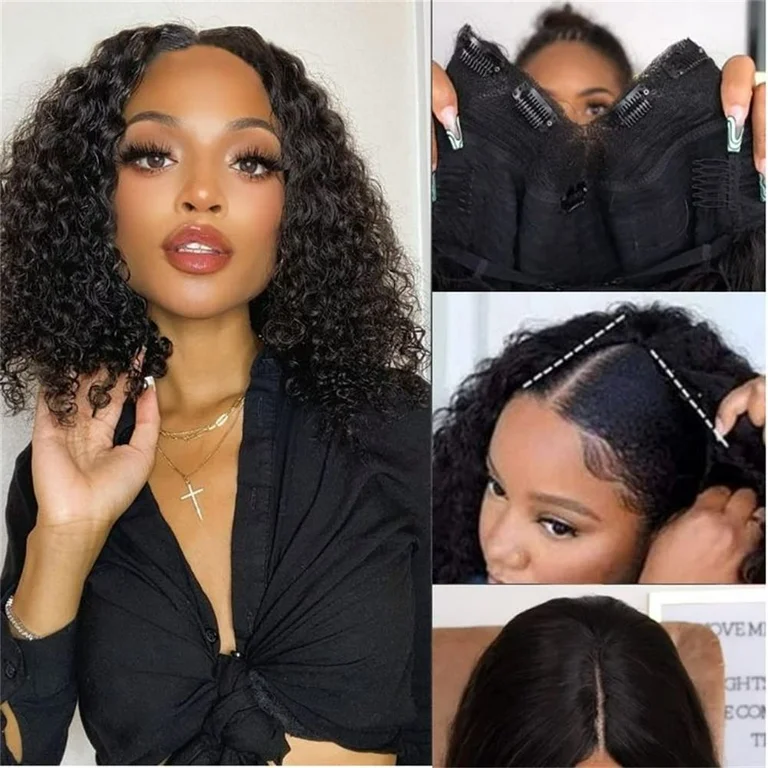
Understanding Synthetic Wig: A Comprehensive Guide
What Is a Synthetic Wig?
A synthetic wig is a hairpiece made from artificial fibers designed to mimic the appearance and texture of human hair. These wigs utilize various synthetic materials, such as polyester, acrylic, and polyvinyl chloride (PVC), to create strands that resemble natural hair. Manufacturers employ advanced technologies to produce fibers that closely match the look and feel of different hair types and textures. Synthetic wigs offer a convenient and often cost-effective alternative to human hair wigs. They come in a wide range of styles, colors, and lengths, catering to diverse preferences and needs.
One of the key advantages of synthetic wigs is their ability to maintain their style even after washing, eliminating the need for frequent styling. This feature makes them particularly appealing to individuals who desire a low-maintenance hair solution. Synthetic wigs have gained popularity among fashion enthusiasts, cosplayers, and individuals experiencing hair loss due to medical conditions or treatments. As technology advances, the quality and realism of synthetic wigs continue to improve, making them an increasingly attractive option for those seeking versatile hair solutions.

The History and Evolution of Synthetic Wigs
The concept of wigs dates back to ancient civilizations, but synthetic wigs are a relatively modern invention. The development of synthetic fibers in the mid-20th century paved the way for artificial hair pieces. Early synthetic wigs were often stiff and unnatural-looking, limiting their appeal. However, advancements in polymer science and manufacturing techniques led to significant improvements in the quality and appearance of synthetic hair fibers. The 1960s and 1970s saw a surge in popularity for synthetic wigs as they became more affordable and accessible to the general public.
During this period, synthetic wigs were often associated with bold, fashion-forward styles. As technology progressed, manufacturers began producing more realistic-looking synthetic fibers. The introduction of heat-resistant fibers in the 1980s allowed for greater styling versatility, further enhancing the appeal of synthetic wigs. Today, high-quality synthetic wigs can be nearly indistinguishable from human hair wigs, offering a wide range of options for consumers. The evolution of synthetic wigs continues, with ongoing research focused on improving durability, texture, and overall appearance.
Types of Synthetic Fibers Used in Wigs
Synthetic wigs utilize various types of artificial fibers, each with unique properties and characteristics. The most common synthetic fibers include modacrylic, polyester, and polyvinyl chloride (PVC). Modacrylic fibers are flame-resistant and offer a natural-looking sheen, making them a popular choice for high-quality synthetic wigs. Polyester fibers are known for their durability and ability to hold style well, even in humid conditions. PVC fibers are often used in lower-cost wigs and are valued for their affordability and ease of production.
Some manufacturers blend different types of synthetic fibers to achieve specific textures and appearances. For instance, combining modacrylic and polyester fibers can result in a wig that balances natural appearance with durability. Advanced synthetic fibers, such as Kanekalon and Toyokalon, offer improved heat resistance and styling versatility. These fibers can withstand higher temperatures, allowing for limited heat styling options. Newer innovations in synthetic fiber technology aim to create fibers that more closely mimic the structure and behavior of human hair, resulting in increasingly realistic-looking wigs.

Advantages of Synthetic Wigs
Synthetic wigs offer numerous advantages that make them an attractive option for many users. First and foremost, they are generally more affordable than human hair wigs, making them accessible to a wider range of consumers. Synthetic wigs require minimal styling, as they are pre-styled and maintain their shape even after washing. This feature saves time and effort in daily hair care routines. Additionally, synthetic wigs are lightweight and comfortable to wear, reducing strain on the scalp during extended use. They also offer excellent color retention, maintaining their vibrancy longer than human hair wigs.
Synthetic wigs are available in a vast array of styles and colors, allowing users to experiment with different looks without committing to permanent changes. These wigs are also hypoallergenic, making them suitable for individuals with sensitive skin or allergies to certain hair products. The durability of synthetic fibers means that these wigs can withstand exposure to various environmental factors, such as wind and rain, without losing their style. For those undergoing medical treatments or experiencing hair loss, synthetic wigs provide a quick and easy solution to restore confidence and maintain a desired appearance.
Limitations of Synthetic Wigs
While synthetic wigs offer many benefits, they also have some limitations that users should consider. One of the primary drawbacks is the limited styling versatility compared to human hair wigs. Most synthetic wigs cannot be heat-styled, as high temperatures can damage the fibers. This restriction means that users are generally confined to the pre-styled look of the wig. Although some heat-resistant synthetic wigs exist, they still have temperature limitations and may not achieve the same styling results as human hair.
Synthetic wigs typically have a shorter lifespan than human hair wigs, lasting about 4-6 months with regular wear. The artificial fibers can become frizzy or tangled over time, diminishing the wig’s appearance. Some users find that synthetic wigs lack the natural movement and shine of human hair, potentially appearing less realistic in certain lighting conditions. Synthetic wigs can also be less breathable than human hair wigs, which may cause discomfort in hot weather or during physical activities. The inability to color or permanently alter synthetic wigs limits customization options. Finally, some high-end synthetic wigs can be expensive, narrowing the cost gap with human hair wigs and potentially reducing their cost-effectiveness for some users.

Caring for Synthetic Wigs
Proper care and maintenance are essential to extend the lifespan and maintain the appearance of synthetic wigs. Washing synthetic wigs requires special attention to preserve their style and shape. Users should wash their synthetic wigs every 6-8 wears or when they begin to look dull or feel sticky. Use cool water and a gentle shampoo specifically designed for synthetic hair to clean the wig. Avoid rubbing or twisting the hair, as this can cause tangling and damage to the fibers. Instead, gently swish the wig in the soapy water and rinse thoroughly. After washing, pat the wig dry with a towel and place it on a wig stand to air dry completely. Never use heat to dry a synthetic wig, as this can damage the fibers.
Between washes, use a wide-toothed comb or a wig brush to detangle the hair gently, starting from the ends and working up to the roots. Store synthetic wigs on a wig stand or in a wig box to maintain their shape and prevent tangling when not in use. Avoid exposing synthetic wigs to high heat sources, such as ovens, grills, or open flames, as this can melt or damage the fibers. By following these care instructions, users can significantly extend the life and maintain the quality of their synthetic wigs.
Styling Options for Synthetic Wigs
While synthetic wigs have some styling limitations compared to human hair wigs, there are still various options for customizing their appearance. Many synthetic wigs come pre-styled, allowing users to choose from a wide range of looks without additional styling. For those seeking versatility, some manufacturers offer heat-resistant synthetic wigs that can withstand temperatures up to 350°F (175°C). These wigs allow for limited heat styling, such as gentle curling or straightening, to alter the wig’s appearance. However, it’s crucial to use low heat settings and heat-protective products to prevent damage. Non-heat styling methods can also be employed to change the look of a synthetic wig.
Using rollers or pin curls can add body and waves to straight wigs, while finger-combing and shaking can create a more tousled, relaxed appearance. Some users experiment with braiding or using hair accessories to create different styles. Trimming synthetic wigs is possible but should be done cautiously and preferably by a professional to maintain the wig’s shape and appearance. For those who frequently change their style, owning multiple synthetic wigs in different styles and colors can be a cost-effective way to achieve versatility without compromising the integrity of a single wig.

Choosing the Right Synthetic Wig
Selecting the perfect synthetic wig involves considering several factors to ensure satisfaction with the purchase. First, determine the desired length, color, and style that best suits your face shape and personal preferences. Many wig retailers offer online tools or in-store consultations to help match skin tone and face shape with flattering wig styles. Consider the cap construction of the wig, as this affects comfort and security. Options include basic caps, capless designs, monofilament tops, and lace fronts, each offering different levels of comfort and realism.
The intended use of the wig also plays a role in selection. For daily wear, opt for high-quality, durable synthetic fibers that can withstand regular use. For occasional or costume use, less expensive options may suffice. Take into account the level of care and maintenance you’re willing to commit to, as some styles and cap constructions require more attention than others. When possible, try on wigs before purchasing to assess comfort and appearance. Many retailers offer return policies, allowing you to exchange the wig if it doesn’t meet your expectations. Lastly, consider your budget, balancing quality with cost to find a synthetic wig that meets your needs without breaking the bank.
The Future of Synthetic Wig Technology
The synthetic wig industry continues to evolve, with ongoing research and development aimed at improving the quality, realism, and versatility of artificial hair. Advancements in fiber technology are focusing on creating synthetic strands that more closely mimic the structure and behavior of human hair. This includes developing fibers with improved heat resistance, allowing for greater styling options without compromising the wig’s integrity. Innovations in manufacturing processes are enhancing the natural appearance of synthetic wigs, including more realistic hair movement and light reflection properties.
Some companies are exploring bio-based synthetic fibers, aiming to create more environmentally friendly and sustainable wig options. The integration of smart technology into wigs is another area of development, with concepts like color-changing fibers or wigs that adapt to environmental conditions being explored. Improvements in cap construction continue to enhance the comfort and breathability of synthetic wigs, making them more suitable for long-term wear. As technology progresses, the line between synthetic and human hair wigs may become increasingly blurred, offering consumers even more high-quality, realistic options in the future.
The Impact of Synthetic Wigs on Fashion and Society
Synthetic wigs have significantly influenced fashion trends and societal perceptions of hair. These affordable and versatile hairpieces have democratized access to different hairstyles, allowing individuals to experiment with their look without permanent changes. In the fashion industry, synthetic wigs have become a staple for runway shows and photo shoots, enabling quick and dramatic transformations. The entertainment industry heavily relies on synthetic wigs for costumes in theater, film, and television productions.
Synthetic wigs have also played a crucial role in supporting individuals experiencing hair loss due to medical conditions or treatments. Helping to maintain self-esteem and normalcy during challenging times. The increasing quality and realism of synthetic wigs have contributed to reducing stigma around wig-wearing. Making it more socially acceptable as both a fashion choice and a practical solution for hair loss. As synthetic wigs continue to improve, they challenge traditional notions of natural hair and expand the possibilities for personal expression through hairstyles.

